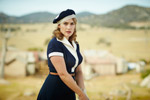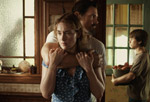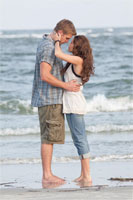Kate Winslet The Mountain Between Us
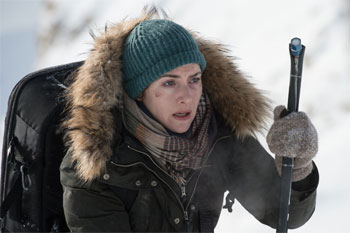
What if your life depended on a stranger?
Cast: Kate Winslet, Idris Elba
Director: Hany Abu-Assad
Genre: Drama, Romance
Rated: M
Running Time: 108 minutes
Synopsis: Stranded after a tragic plane crash, two strangers must forge a connection to survive the extreme elements of a remote snow covered mountain.
The Mountain Between Us
Release Date: October 12th, 2017
About The Production
A Harrowing Adventure, An Epic Romance
With his novel The Mountain Between Us, author Charles Martin fashioned a suspenseful, affecting tale that examines how two strangers with distinctive personalities compromise and adapt to one another under extreme duress. That story"the unfolding tale of how two compelling protagonists make their way across a brutal landscape toward salvation, and ultimately, love"spoke to Oscar®-nominated producer Peter Chernin (Hidden Figures). At its core, the tale offered an endearing exploration of humanity's optimistic, loving and giving spirit that reminds us to always have hope and live in the present.
The veteran filmmaker optioned Martin's novel five years ago aiming to translate the unusual love story built for the big screen, making a film in the tradition of such classics as Dr. Zhivago and Out of Africa.
'I was highly attracted to the idea of doing a love story with scale," Chernin says. 'I was just highly impacted by this story of essentially two broken or incomplete people who, through this experience, change their lives and grow into who they are. These are two people in the most extreme situation imaginable. The fact that they fall in love is one of the reasons that allows them to survive this extraordinary ordeal."
 By almost any account, Alex Martin and Ben Bass an unlikely pair. Both are exceedingly accomplished and committed to their respective professions, but there, the similarities end. Alex is bold, fearless and feisty, a photojournalist known for her maverick methods and dogged determination. True to form, she cuts it close traveling back to New York and ends up stuck in Idaho the day before her wedding to long-term boyfriend Mark. When her flight is cancelled due to inclement weather, she is determined to find a solution, partnering with a stranger to charter a flight that will get them both closer to their destination.
By almost any account, Alex Martin and Ben Bass an unlikely pair. Both are exceedingly accomplished and committed to their respective professions, but there, the similarities end. Alex is bold, fearless and feisty, a photojournalist known for her maverick methods and dogged determination. True to form, she cuts it close traveling back to New York and ends up stuck in Idaho the day before her wedding to long-term boyfriend Mark. When her flight is cancelled due to inclement weather, she is determined to find a solution, partnering with a stranger to charter a flight that will get them both closer to their destination. Ben Bass is a renowned children's neurosurgeon on his way to New York to perform a vital, complicated procedure the following morning. He is precise, methodical and disciplined, both in life and career and, though reluctant to board a small plane, he sees no other option. That decision sets in motion a harrowing series of events that will set the stage for Alex and Ben to forge a deep, unique and lasting bond.
Starring as Alex and Ben are two of the most respected actors working today: Academy Award winner Kate Winslet (The Reader) and Golden Globe winner Idris Elba (Luther).
'These are two serious, world-class actors," Chernin says. 'The idea of putting them together in this sort of intense, emotional story made it feel more special. Both of them came to this with a serious level of commitment. They were incredibly excited about playing off each other and deeply committed to making this story something of quality."
Winslet has a nearly unparalleled resume studded with standout performances stretching back decades"she's often said that she likes to play women she considers 'ballsy," a description that certainly applies to Alex. 'She's the kind of woman who won't give up until she's got her story," Winslet says. 'She's one of those women who's been in war zones before, worked around the clock, gone without sleep. She's brave, extremely brave."
In Alex, she says she saw the opportunity to portray a strong female protagonist whose mental strength and clarity become vitally important to her survival, a woman who is every bit as well drawn and alive as Ben. 'When I first read the script, I was actually attracted to both Alex and Ben," Winslet says. 'I loved the idea that these two characters would sustain an entire film from start to finish. I've never read a script like that before. And I also really believe in what the story says"that you can change, as a person, in immeasurable ways, and it's perfectly possible to experience something in your life and then never really be able to go back to the way your life was, or forward to what you thought your life was going to become. So much changes for these two characters through the experience that they share. I was very captivated by that."
Likewise, Idris Elba, well known for searing turns on the BBC series Luther and in films such as Beasts of No Nation and Mandela: Long Walk to Freedom, was drawn to the role of Ben, a man as strong and capable as he is handsome. 'The story and the extreme circumstances these two people find themselves in was very appealing to me," he says. 'It felt like something I could dramatically really get my teeth into. Also, I hadn't done a romantic lead yet, so this is quite a departure.
'This movie examines the concept that there's no perfect scenario to meet someone you're going to fall in love with," Elba adds. 'In fact, sometimes the most extreme scenarios become a better place to understand if you can love someone or not because you're facing them in a circumstance that isn't comfortable. As an actor, you have to put yourself there as closely as you can to whatever the character is going through and Ben has gone through a lot. His personal life is in turmoil when we meet him and becomes ever more complicated on this mountain."
To tell this gripping story of romance and survival, Chernin and producer Jenno Topping ultimately turned to acclaimed Palestinian director Hany Abu-Assad, the Oscar-nominated filmmaker known for his foreign-language dramas Omar and Paradise Now, both political dramas dealing with themes of occupation and oppression.
'The thing about Hany is that he leads with his heart, and he's not afraid of all the colors and the emotional scale," Topping says. 'He wants to explore the outer limits of the emotional range that humans are capable of, whether that's love or fear or danger or sorrow. And he communicates that so effectively. Once we realized that not only would he bring the quality that he brings to all his work, but that he also wanted to reach for a bigger, more muscular palette, we felt totally comfortable."
In The Mountain Between Us, Abu-Assad saw the chance to direct an expansive, inherently cinematic story of a man and woman struggling against the elements that also functions as an intimate, moving two-hander. 'The script was about the good nature of human beings and their spirt to allow them to become better human beings, to survive, to be able to love, to be able to sacrifice," Abu-Assad says. 'That felt to me like an interesting theme to dig into. This is indeed my biggest movie ever. There are a lot of differences from my small projects, but also a lot of similarities, and the principle is the same. In the end, whether it's a small or big movie, it's about storytelling."
Winslet was familiar with the boundary-pushing director's earlier films and was eager to collaborate with him. 'I had seen Hany's previous work and loved his storytelling," she says. 'It's very, very simple and yet deals with extremely complex emotions that are often quite difficult to portray on film. They're often bound up in conflict and tragedy and yet somehow, he is able to convey those things on film in a gentle way that is captivating and also humorous at times. It's perfectly possible to find moments of great random humor in extreme situations or moments of great tragedy and sadness. And I really admire the way that he handles that in his filmmaking."
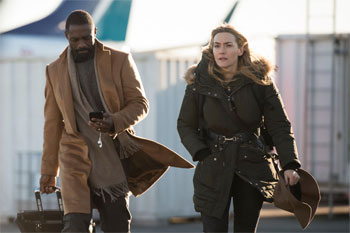 The story of The Mountain Between Us is set dramatically into motion once the pilot of the plane Alex and Ben have charted suffers a stroke mid-flight, and the craft crashes" respected actor Beau Bridges appears in a brief but memorable term as the doomed man. When Ben first emerges from the wreckage, he takes in the full isolation and desperation of their predicament. Making matters worse, Alex is severely injured"she's unconscious for nearly two days. Ben uses his medical training to tend to her wounds, and after she finally wakes, he suggests that they settle in and remain calm, that help surely will arrive shortly. It's Alex who realises that the pilot never filed a flight plan, meaning if they are to survive, they must take action"and quickly.
The story of The Mountain Between Us is set dramatically into motion once the pilot of the plane Alex and Ben have charted suffers a stroke mid-flight, and the craft crashes" respected actor Beau Bridges appears in a brief but memorable term as the doomed man. When Ben first emerges from the wreckage, he takes in the full isolation and desperation of their predicament. Making matters worse, Alex is severely injured"she's unconscious for nearly two days. Ben uses his medical training to tend to her wounds, and after she finally wakes, he suggests that they settle in and remain calm, that help surely will arrive shortly. It's Alex who realises that the pilot never filed a flight plan, meaning if they are to survive, they must take action"and quickly. 'Ben's character is always erring much more on the side of caution than Alex," Winslet says. 'So, whereas he would have much preferred to stay put in that plane and wait in hopes of a rescue, Alex says, -We might just have to get ourselves out of this awful situation and either you're with me or you're not.' Her courage to go out and start trying to make that journey to safety and back to civilization is the thing that actually does drive the story forward."
To make it out of the mountains alive, Alex and Ben will have to cover miles and miles of punishing terrain. With meager supplies, they set out, accompanied by the pilot's faithful dog. The going is slow, and along the way, the survivors become increasingly dependent on one another as they face a series of perilous situations. Her mental and his physical wherewithal are both needed to overcome the imminent danger they are in.
'They definitely clash over their strategic maneuvers throughout the story, but those are the things that bring them together," Winslet says. 'They have to work together. They have to get through those differences. And then it does take them to the point where they can't be without one another."
They also begin to learn intimate details about each other's lives"though the expressive Alex is initially more forthcoming than the reserved Ben. She reveals that she's only recently committed to marrying Mark, played by Dermot Mulroney, while introverted Ben, on the other hand, secretly and sparingly listens to classical music on his cell phone, a reminder of his loving wife who passed away from cancer years before. They selflessly begin to care for one another. No matter the threat, neither is willing to leave the other behind.
'This film is about falling in love," says producer David Ready. 'At the outset of their relationship, it's very much yin and yang. As they face the same jeopardy and challenges, their characters learn from one another and grow. Alex gets softer, Ben gets louder, braver, and they start to come together in order to survive."
'This is a total romance," adds Topping. 'It's such an incredibly beautiful part of the movie actually"when you go through something so extreme with someone, there is nobody else in the world who knows you like as intimately. If somebody loves you after that, after going through that and seeing it all, there will never be another human who you can connect in the same way."
Much like Alex and Ben, Winslet and Elba approached their roles differently but with the same intense commitment to character. 'I'm quite a lot about dialogue and making sure that we've got the lines down and that we know what we're doing," Winslet says. 'Idris would be very much like, -Don't worry about that stuff. It's all about the energy. It's all about the atmosphere.' We had to kind of adapt to each other's way of working because both ways of working were completely relevant and we needed both of those qualities to be able to get through [the experience of filming]. We did learn a lot from each other."
'Kate brought a level of deepness and honesty about the emotions that Alex goes through," Elba adds. 'She's very analytical about the words and the script, and we spent a lot of time breaking it down to the finest detail to make it ring true. When you've got two actors playing characters that go through something that is very real"survival, love"it's important that you really look for the truth in that because the audience can see through it. Kate was very vigilant and very honest. She gave away stuff about herself to play this role. We both did. We had to."
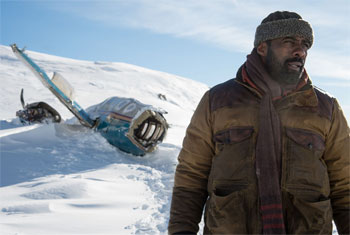 Scaling The Mountain
Scaling The Mountain To film a story set in the most remote mountainous region in the United States"filled with beautiful yet dangerous landscapes"Abu-Assad insisted that all exterior mountain scenes be shot in a way that mirrored the life-threatening conditions that Alex and Ben are forced to endure without the use of green screen. That meant finding a location accessible for filming that had all the same imposing mountain peaks and blankets of deep, undisturbed snow that awaits the travelers, and recruiting a team behind the camera who would not be cowed by working under inhospitable conditions.
'The movie's kind of simple when you think about it"it's two people and a dog on a mountain," says Ready. 'And yet it's highly complex in terms of production and how you're going to achieve a movie that takes place in these extreme environments. Authenticity was a hugely important goal for us"the authenticity of the environment helps with the authenticity of the performances. It's all one and the same."
The Mountain Between Us landed in the picturesque community of Invermere in the Percell Mountain range at the southeast corner of British Columbia, Canada, which had precisely the right mix of extraordinary vistas and unforgiving terrain required to lend credibility and authenticity to the film. Before heading out to the remote site, however, Abu-Assad and his crew"including cinematographer Mandy Walker, production designer Patrice Vermette and costume designer Renée Ehrlich Kalfus"staged one of the film's most staggering set pieces on a Vancouver sound stage.
To simulate the terrifying plane crash and Alex and Ben live through, the production manufactured a replica fuselage, which was then mounted onto a gimbal and rigged for complex, unconventional camera moves. The fuselage itself was one complete set with no removable side walls"to access the interior, the actors had to climb through a small side window of the plane. The crash scene, captured in one continuous travel shot, was achieved by mounting the camera onto a single cable that entered from the open nose of the aircraft. Guided by remote control, the camera travelled 360 degrees in coordinated movements to cover the actors' performances.
'We filmed the scene in one shot that Hany had designed, and it was amazing," Bridges says. 'I'd never done anything like it in my life. The camera, mounted on a line, was moving back and forth inside the airplane. The section in the front had to come away so the camera could swing around and get me in the pilot seat and then it would move back to get Idris and Kate in the rear of the plane. The wind is howling, the plane is shaking"and what I especially loved about that shot was that it really needed everybody's efforts to pull it off."
Although the sequence required an immense amount of precision to film, Abu-Assad felt it was necessary to help create a sense for the audience of being trapped inside the plane with Alex and Ben. 'We came up with the idea to be inside the airplane with one shot because, when cutting scenes together, the audience feels manipulated and not really part of the action," the director says. 'By shooting it as one continuous scene, they are on board, sitting there with the other passengers. But how to execute it? It became an enormous merging of engineering, actors, and direction. The camera movements had to go fluently without disturbing the actors. It was not easy."
As difficult as the crash was to stage, it appeared simple next to the challenges that awaited the production once they arrived at the Percell Mountains in January 2016. Situated on the west side of the Rocky Mountain Trench, Percell's peaks are near or above 11,000 feet in elevation. All the high alpine areas were accessible only via three specialty Bell helicopters, designed and equipped to handle soaring altitudes.
 Safety teams were on constant watch for threats from natural hazards such as avalanches, and sudden weather changes were another very real danger. If bad weather were to move in without warning, the helicopters might not have time to fly from the large landing field where they were stationed to the remote locations to transport the stars and the crew off the mountain and back to lower ground. The production positioned survival huts and survival gear at every location to allow those potentially left behind on the mountain a safe place to wait out any storm. In an abundance of caution, just Winslet, Elba and essential crew flew to the highest elevations where, in addition to the cold, the thinner, high-altitude air made work much more physically demanding. Even breathing at such dizzying heights severely challenged the cast and skeleton crew.
Safety teams were on constant watch for threats from natural hazards such as avalanches, and sudden weather changes were another very real danger. If bad weather were to move in without warning, the helicopters might not have time to fly from the large landing field where they were stationed to the remote locations to transport the stars and the crew off the mountain and back to lower ground. The production positioned survival huts and survival gear at every location to allow those potentially left behind on the mountain a safe place to wait out any storm. In an abundance of caution, just Winslet, Elba and essential crew flew to the highest elevations where, in addition to the cold, the thinner, high-altitude air made work much more physically demanding. Even breathing at such dizzying heights severely challenged the cast and skeleton crew. 'I'd never done anything even really close to this in terms of altitude," Winslet says. 'Running at altitude is absolute agony. It makes your chest burn. I'm a strong, fit person, but that was one thing that I wasn't prepared for at all. You use so much more energy just to breathe when you're up that high. It was all really new to me how to keep ourselves warm, how to look after one another, how to feed yourselves properly, stay hydrated, all of those kinds of things. It was proper survival."
Cinematographer Walker (Tracks, Australia) was no stranger to filming in demanding environments, and her ingenuity knew no limits when planning shots in the wintery terrain: at one point, she mounted a camera on a sled made of snowboards to capture the perfect image for Abu-Assad.
The extreme conditions did little to sway Abu-Assad from pursuing a startling cinematic vision"despite the unforgiving climate, he still sought to capture sweeping, majestic shots, again without relying on green screen or digital trickery. Walker even requested a custom lens from Panavision for certain scenes. 'For him, the camera is all about storytelling," Walker says. 'We don't do a lot of cuts or cutaways"it's not a handheld movie. We try and get the shot to tell the audience what's going on for the characters at that moment. We move in the way that they move and try to be in sync with their journey."
In some instances, trekking alongside Alex and Ben created its own set of problems. 'Sometimes, we could do only one or two takes because once the characters made footprints, we couldn't go over the same piece of ground again," Walker says.
Likewise, two-time Academy Award-nominated production designer Patrice Vermette (Arrival, The Young Victoria) had to take early precautions to create the sets needed for the mountain scenes. Vermette's team constructed the plane in Vancouver and then oversaw its transport to the mountainous terrain. The fuselage, including part of a wing and the engine, was carried by helicopter to its resting place at 9,000 feet. The tail section, which is torn away in the crash, was placed at 9,500 feet on the edge of the Delphine glacier.
Every piece of the plane was weighed so that when it came time to airlift it into position, the helicopter pilots flying the crafts carrying the sets knew exactly how much they could safely carry on any given trip.
Because aircraft are constructed from lightweight materials and high alpine wind gusts can be exceedingly powerful, there was concern that the set pieces might be blown away once they were in position in the mountains. To keep them secure, they were fashioned to large 4 x 8 three-quarter inch steel plates buried in the snow. Still, the wind managed to blow one piece of the tail section off the mountain, and it was never recovered. With time in short supply, a second tail section had to be built, painted, aged and distressed in Vancouver then driven up to the mountains to be airlifted and anchored into position.
To further dress the area around the tail section, six 6' x 3' boulders were created out of foam, flown up by helicopter, and attached to large cross plates of wood, which were then buried in the snow. Mother Nature added the final dressing with even more snow.
Other principal mountain sets, including a stump-root shelter and the entrance to a snow dome cave, were built around the perimeter of the production's home base, a nearby plateau known as Horsethief Creek, where trailers, equipment trucks, generators, mobile units, and transportation vehicles were all staged. The area essentially acted as an on-location back lot, allowing Abu-Assad to continue to shoot even if the actual mountain locations were inaccessible. The design team began their preparations in November, before the ground froze. The largest build was a dilapidated cabin where Ben and Alex shelter after she suffers a frightening fall through the ice into frigid waters below. 'The idea with the cabin was to create something that was almost a ghostlike, ephemeral," says art director Cheryl Marion. 'It's there, but unless you're really looking for it, you don't see it. When Ben first glimpses it, it's really not evident that it's there. And that was the whole point"that it had this ghostlike feel."
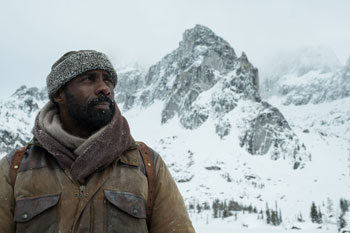 Like the plane's fuselage and tail, the cabin was built on a Vancouver stage and trucked more than 500 miles in often treacherous winter driving conditions to Horsethief Creek. There, over the course of eight days, it was reconstructed on a vast open field and then distressed to give the appearance that it was long abandoned. The production's greens team returned in early December, planting willows and larger trees to create a dramatic backdrop for the scene. By the time cast and crew arrived at the beginning of January 2016 to begin filming, it was as if the sets had been a part of the landscape for many years.
Like the plane's fuselage and tail, the cabin was built on a Vancouver stage and trucked more than 500 miles in often treacherous winter driving conditions to Horsethief Creek. There, over the course of eight days, it was reconstructed on a vast open field and then distressed to give the appearance that it was long abandoned. The production's greens team returned in early December, planting willows and larger trees to create a dramatic backdrop for the scene. By the time cast and crew arrived at the beginning of January 2016 to begin filming, it was as if the sets had been a part of the landscape for many years. 'From the beginning Hany, Mandy and I wanted to have the authenticity of the landscape"not using green screen because I think there are so many green screen movies nowadays that the audience's eyes can pick up when it's real or not," Vermette says. 'We wanted to have the real light, the real landscapes, the real precipice. Yes, it becomes much more difficult for production to go that route. But I think everybody was extremely proud of what was accomplished every day."
Executive producer Becki Cross Trujillo handled many of the complex logistics, consulting with the helicopter pilots and location manager Robin Mounsey to determine if it would be safe to film on a given day. If the all-clear was given, Trujillo would travel to the day's location with Abu-Assad, Walker, Mounsey, and first assistant director Paul Barry to ensure that the actors and the remainder of the necessary crew and equipment would be able to make it to the set from Horsethief Creek.
'If we could, they would drop us on the mountain and radio down," Trujillo says. 'Everybody on the ground would start mobilizing to get all the equipment and other gear ready to come up in the other two helicopters. We never pushed to try to get up on the mountain when the pilots and location manager had concerns. They led that charge, and we trusted them because we wanted everybody to be safe."
In addition to protecting the cast, crew and equipment from frigid conditions, Trujillo was tasked with caring for canine cast member, Raleigh, who plays the other survivor of the crash, the pilot's dog. 'He wore a human down jacket," Trujillo says. 'He learned to wear goggles. They waxed his paws to protect them, and we kept shoes on him. He learned to get in and out of the helicopter, and we had a Styrofoam pad that we had him standing and laying on so that he was off the ice. It was a learning curve for him"luckily, he was a laid-back, wonderful dog. We could throw scarves and hats on him, and he was just fine with that."
The bitter cold proved relentless and unforgiving. The first week at the location saw an unusual weather inversion where temperatures in the valley were colder than those up in the high alpine. Sub-zero conditions caused truck engines, generators, camera gear and other equipment to freeze up or break down. Bales of hay were packed around all trucks, motor homes and trailers to keep heat contained. Frostbite was a concern. In all, The Mountain Between Us spent 18 days in the harsh terrain.
'It was truly really freezing cold," Winslet says. 'In fact, there was one day on the mountain where every single thing we shot we did it in one take, because it was just so darn cold you had to get through it. Even taking off your gloves for two seconds was excruciating."
Costume designer Renée Ehrlich Kalfus was mindful of the severe weather conditions the cast would be exposed to for the entire time they were filming on the mountain, and she did what she could to mitigate the actors' discomfort. 'They really didn't complain about the cold," she says. 'They had warmers, electric socks, battery run mittens, but their faces were exposed."
Dressed as he is in fashionable city wear, Ben is particularly ill-prepared for the frigid temperatures and the rugged terrain. 'He's elegant in his cashmere coat and his leather city boots," Kalfus says. But Walter, the ill-fated pilot, was far better outfitted for the bone-chilling climes. 'Because the pilot dies, he puts on the pilot's clothes," Kalfus says. 'So, Idris, in effect, is really acting in somebody else's costume for much of the movie, which was kind of an interesting thing that he went through as an actor. Because the costumes really define who they are."
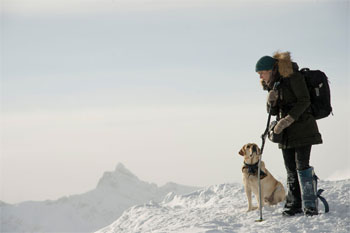 For Kalfus, the chief challenge was creating costumes that not only spoke to the characters' identities"Alex as a resourceful photojournalist, Ben as a wealthy neurosurgeon" but also would hold visual interest for the duration of the film. 'I had to create an original look that could sustain itself through most of the movie," she says. 'I was keyed in to adding a lot of texture and color and framing the face and silhouettes and giving this classic look to both of them that we, as the audience, would not tire of."
For Kalfus, the chief challenge was creating costumes that not only spoke to the characters' identities"Alex as a resourceful photojournalist, Ben as a wealthy neurosurgeon" but also would hold visual interest for the duration of the film. 'I had to create an original look that could sustain itself through most of the movie," she says. 'I was keyed in to adding a lot of texture and color and framing the face and silhouettes and giving this classic look to both of them that we, as the audience, would not tire of." Ultimately, the mountain shoot required all departments to be flexible and rise to the demands of ever changing conditions and schedules, knowing that each day still brought only six hours of usable daylight. 'It wasn't easy at all, actually," Abu-Assad says. 'Many times, I would look at the crew and feel like we were crazy. Why we are doing this? But then we did it, and I'm very glad. I'm proud that we did it this way."
Cast and crew were gratified by what they accomplished during their time in the Percell Mountains"capturing remarkable performances in imposing and formidable terrain, and the vast and stunning grandeur of the landscape as well. Despite the physical hardships, Elba was quick to point out that, 'These mountains are beautiful, the views go on forever, and you feel quite special. I felt very privileged to be able to make this movie and see these vistas that probably not many human beings will ever get to see in real life."
Says Chernin, 'From the very beginning, we felt that this movie had to look extraordinary. It had to look on the scale and scope of the kind of movies that very seldom get made today. This is a movie about survival. This is a movie about people being pushed to the edges of human tolerance and endurance. What they have put themselves through is extraordinary."
The Mountain Between Us
Release Date: October 12th, 2017
Have You Seen This?
MORE
- Mission: Impossible Fallout
- Glenn Close The Wife
- Allison Chhorn Stanley's Mouth Interview
- Benicio Del Toro Sicario: Day of the Soldado
- Dame Judi Dench Tea With The Dames
- Sandra Bullock Ocean's 8
- Chris Pratt Jurassic World: Fallen Kingdom
- Claudia Sangiorgi Dalimore and Michelle Grace...
- Rachel McAdams Disobedience Interview
- Sebastián Lelio and Alessandro Nivola...
- Perri Cummings Trench Interview

